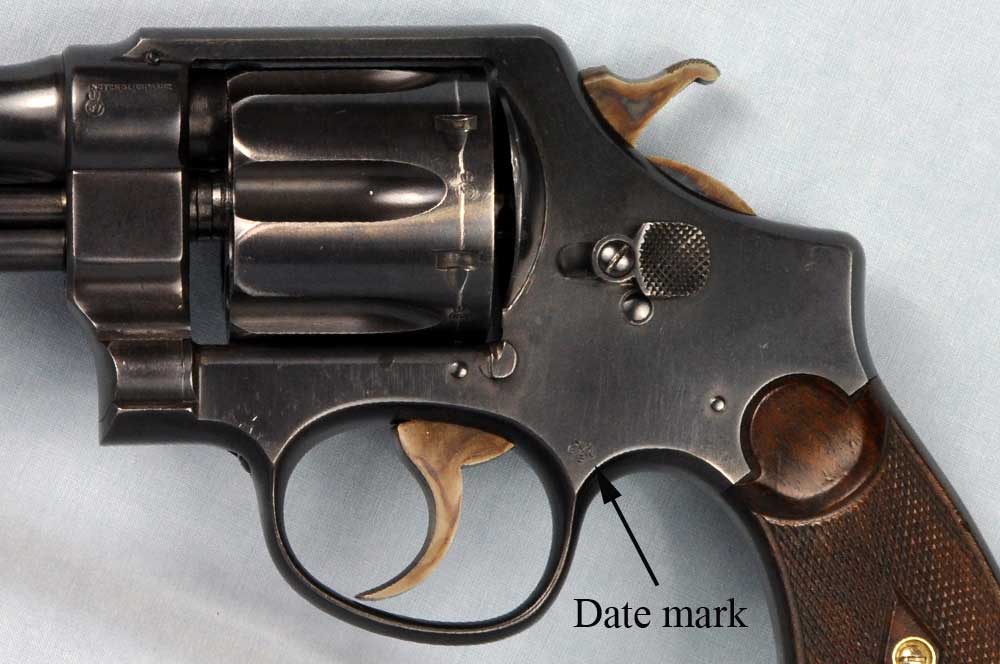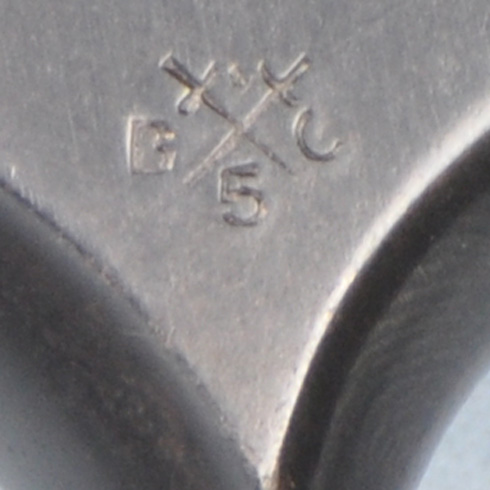Thanks to all for you comments. Please keep them coming.
Quote:
Originally Posted by Texas Star

The grips sure seem well matched, and nicely figured, but did they shrink at the top, or what?  |
You have lost me on that question. The grips fit perfectly to my observation.
Quote:
Originally Posted by Texas Star

The UK proofs may indicate a gun sent to Britain in 1940...or not. Can anyone here tell by the stamps when it was proofed?
|
Yes, there is a ready answer. This revolver was submitted to the Birmingham Proof House for commercial proof in 1952. Stamped just behind the trigger on the left side is the Birmingham private viewer's date mark:

A close-up of the stamp:

This mark, with the "B" on left, the "C" on right, and "5" below tells us that the revolver was inspected by the 5th ranked viewer of the Birmingham Proof House in 1952.
There are no martial marks on the revolver at all. It never was in the hands of the British military, as it would have the "broad arrow" and a military acceptance mark in that event.
Quote:
Originally Posted by Texas Star

I note that this is a .44, not a .455, and the early serial number MAY suggest that it was indeed sent to Britain soon after being made.
|
Now I'm at the edge of my understanding of British proof laws. I believe their laws would require the firearm to undergo proof upon importation. This would mean either military acceptance or civilian proof. If I am correct in this belief, then the stamps attest the fact that the revolver was imported to Britain in 1952.
As a corollary, we see many S&W revolvers that went to England for WW1. They bear British military acceptance stamps that were applied upon receipt and inspection by the military. When discharged from military service (generally after 1945) they were again stamped with the "broad arrow" (but backward, tip to tip) indicating release. Those that were privately sold in England then went to the commercial proof houses where they received their array of commercial proof stamps, including the "NOT ENGLISH MAKE" stamp. That latter stamp brackets the date of commercial proof to the period of 1925 (when that stamp was introduced) through 1954 (when it was discontinued). So the stamps on those revolvers were applied in three occasions: military acceptance, military discharge, and civilian proof.
So in conclusion, this revolver tells us it was privately imported to England in 1952. At some point in time it made it back to the U.S.; certainly before 1968, as it bears no U.S. import marks mandated in 1968.
There very well may be others who are better versed in British proofing. If so, please speak up.